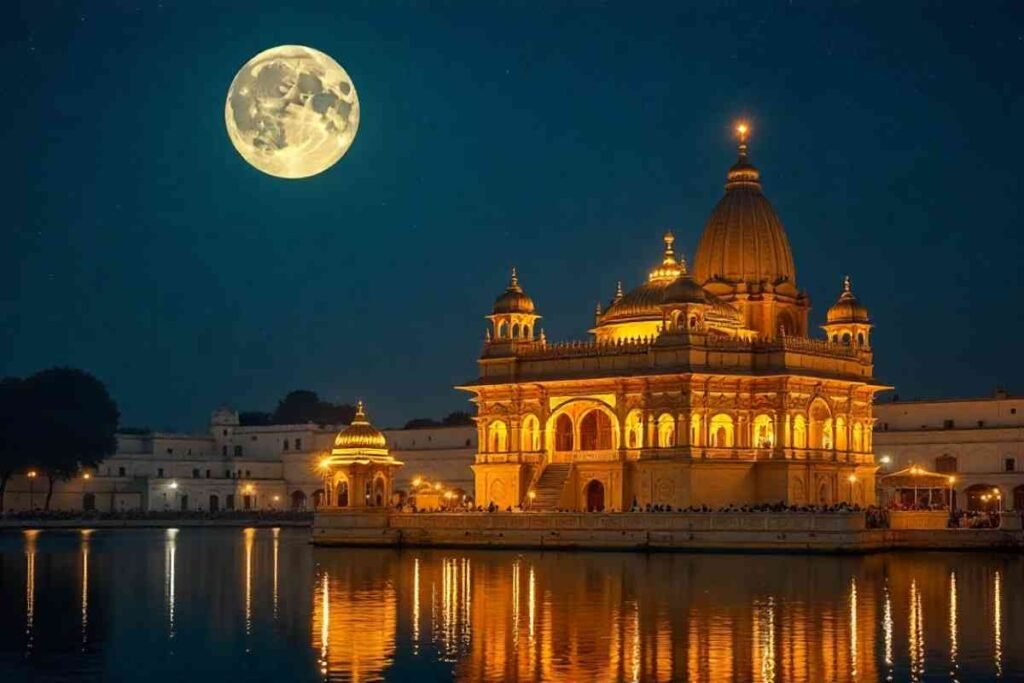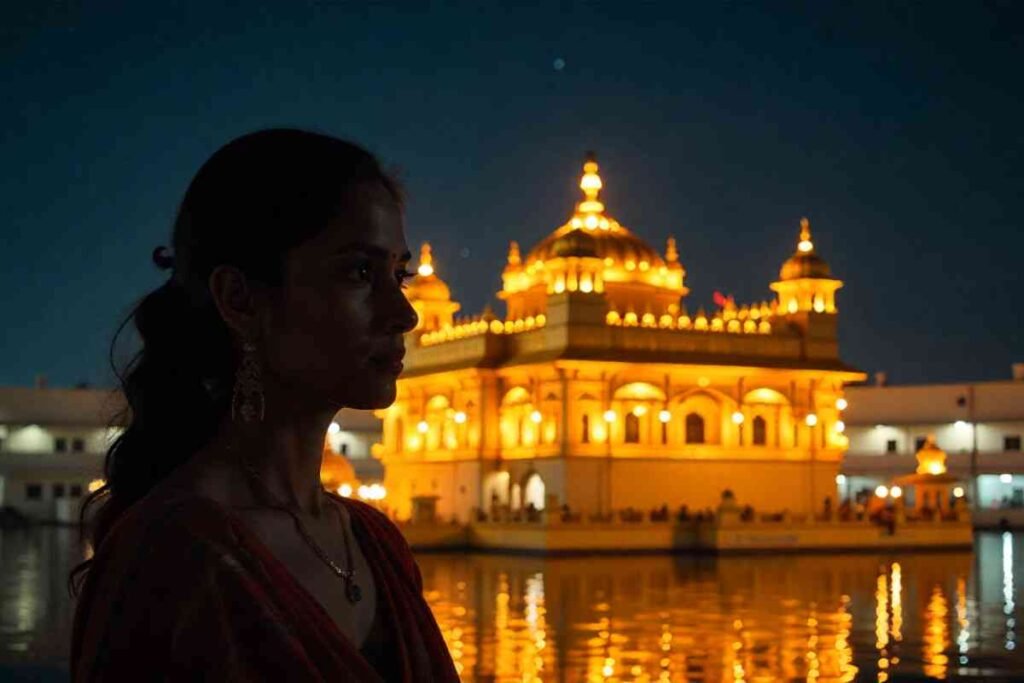Golden Temple Vellore History tells the story of a unique spiritual landmark in Sripuram Tamil Nadu. Known for its pure golden covering it shines as a symbol of devotion and grandeur.
Golden temple vellore history history reflects deep faith and cultural significance attracting countless devotees and visitors every year.
To discover how this golden marvel was built and why it holds such importance explore the full story in this article.
The Origins of Golden Temple Vellore

The origins of Golden temple vellore history back to the vision of spiritual leader Sri Narayani Amma who wanted to create a symbol of peace and prosperity.
Located in Sripuram Vellore the temple was inaugurated in 2007 as a sacred place of devotion. Its construction used pure gold making it one of the largest golden temples in the world.The temple stands as a beacon of spirituality attracting devotees and tourists from across the globe.
The Inspiration Behind the Temple
The story of the Golden temple vellore history begins with the vision of Sri Sakthi Amma a spiritual leader born in 1976 in the town of Vellore. From a young age Amma displayed divine qualities and a deep inclination towards spirituality.
In 1992 Amma proclaimed to be the avatar of Golden temple vellore historyNarayani and established Sri Narayani Peedam with the mission of uplifting humanity transcending religious boundaries and spreading messages of peace truth and service.
The Golden temple vellore history was conceived as a beacon of universal spirituality symbolizing unity devotion and the power of divine energy.
Unlike temples built solely for religious followers this temple was designed as a space for people of all faiths cultures and traditions. Its purpose was not just to be a house of worship but a center of inspiration and transformation.
Establishment Timeline
The foundation for the Golden temple vellore history was laid in the late 1990s after the success of Sri Narayani Peedam’s spiritual and social initiatives.
Construction began around 2000 and continued for nearly seven years. On 24th August 2007 the temple was officially consecrated in a grand ceremony attended by thousands of devotees from around the world.
This marked a new chapter in the Golden temple vellore history placing Vellore on the global spiritual map. What made the project even more extraordinary was that it was built within just seven years a remarkably short period compared to iconic monuments like the Taj Mahal which took 22 years.
Sri Sakthi Amma: The Visionary Behind the Temple!
Sri Sakthi Amma is the spiritual force and guiding light behind the Golden temple vellore history in Vellore inspiring millions with a message of peace and devotion. His vision was to create a temple that spreads harmony unity and divine blessings to all who visit.
Early Life of Sri Sakthi Amma
Born on January 3 1976 as Shakti Subramanian the child who would later be known as Sri Sakthi Amma showed unique divine qualities from birth.
A ray of light along with the markings of chakra and shanka were visible on the baby’s body considered symbols of divinity. From an early age the child was devoted to pujas rituals and daily temple visits.
On May 8 1992 at just sixteen years old Amma declared being the incarnation of Goddess Narayani. This proclamation marked the beginning of a spiritual journey that would not only influence the local community but also attract global recognition.
Mission and Philosophy
Sri Sakthi Amma’s mission has always been to guide humanity on the spiritual path while simultaneously addressing social and humanitarian issues.
The principles revolve around universal values justice peace compassion and service. Amma has initiated numerous social projects including education healthcare environmental conservation and women’s empowerment.
Amma envisioned the Golden Temple Vellore as a focal point where spiritual growth meets service to humanity. The temple’s architecture symbolism and rituals were all aligned with this greater mission.
Sri Narayani Peedam: The Spiritual Headquarters!
Sri Narayani Peedam is a sacred spiritual center in Vellore dedicated to Goddess Sri Narayani and known for its divine atmosphere.
Golden temple vellore history serves as the spiritual headquarters guiding devotees with prayers rituals and teachings that inspire peace and devotion.
Establishment of the Peedam
In 1992 Sri Sakthi Amma moved to Thirumalaikodi a village near Vellore to establish Sri Narayani Peedam which became the headquarters of Amma’s spiritual and humanitarian activities.
At that time Thirumalaikodi was a rural village with minimal infrastructure no running water no streetlights and poor connectivity. Yet it was chosen for its sacredness, as sages had performed penance in this region for centuries.
Temples and Sacred Spaces in Narayani Peedam
Sri Narayani Peedam houses several important temples and sacred sites:
- Sri Narayani Temple: Dedicated to Goddess Narayani.
- Swayambu Temple: The first temple of the Peedam.
- Putthu Sacred Anthill: Considered a divine energy spot.
- Shanti Mandapam Hall of Peace: Venue for spiritual gatherings.
- Yaga Sala Full Moon Hall: Rituals during full moon days.
- Gho Sala Cow Sanctuary: A home for cows reflecting traditional values.
These temples emphasize that the Peedam is not just a religious institution but also a place of holistic spiritual practice.
Architecture of the Golden Temple Vellore
The architecture of the Golden temple vellore history is a stunning blend of traditional Dravidian style and modern craftsmanship fully covered with pure gold sheets. Its intricate carvings spiritual design and dazzling illumination make it one of the most breathtaking temples in India.
Use of Gold in Construction
One of the most striking features of the Golden temple vellore history is its architectural magnificence. More than 1500 kilograms of gold were used in its construction.
The artisans worked with intricate detail transforming gold bars into ultra thin foils which were then carefully mounted onto copper plates. These plates were etched with elaborate designs before being placed onto the temple structure.
Star Shaped Pathway
The temple is uniquely designed with a 1.8 kilometer long star shaped pathway called the Sri Chakra. This path symbolizes the universe and cosmic energy.
Devotees walk this pathway before reaching the sanctum symbolizing a spiritual journey from the outer world toward the divine center. Along the path messages of truth dharma and wisdom are inscribed to inspire and transform visitors.
Vimanam and Crown
The temple’s central crown known as Vimanam or Ardha Mandapam is among the largest temple crowns in history. Its intricate carvings in gold and silver make it a masterpiece of modern temple architecture.
Comparison with Other Monuments
The GGolden temple vellore history was completed in just seven years, a short span compared to monumental works like the Taj Mahal 22 years and the Golden Temple Amritsar around 10 years. This rapid yet detailed construction highlights the dedication and skill of thousands of artisans and workers.
Spiritual Significance of the Temple
The Golden temple vellore history is not just about architecture; it is deeply rooted in spiritual meaning. The temple stands as a symbol of universal peace and divine grace.
Golden temple vellore history location was chosen based on Vastu Shastra ensuring harmony with cosmic energies.
Devotees believe that walking through the star shaped pathway purifies the soul filling individuals with positive energy.
The temple’s sanctum houses the deity Sri Lakshmi Narayani symbolizing wealth prosperity and compassion.
Dress Code at Golden Temple Vellore
The Vellore Golden Temple dress code reflects respect and discipline in a sacred space. Devotees are expected to wear modest, decent clothing.
For women, traditional attire like sarees salwar kameez or kurtis with churidars are recommended. For men kurta pyjamas dhotis or simple shirts with trousers are ideal.
Short dresses nightwear Bermudas and revealing outfits are strictly prohibited. Carrying a dupatta or scarf is encouraged.
Electronic devices including mobile phones and cameras are also not allowed inside the temple. These restrictions ensure that visitors maintain focus on spirituality rather than distractions.
Cultural and Social Contributions

Beyond its spiritual role, the Golden Temple Vellore is also a hub of cultural and humanitarian initiatives. Under the guidance of Sri Sakthi Amma Sri Narayani Peedam has launched programs for:
- Free medical camps and hospitals
- Educational institutions for underprivileged children
- Environmental conservation through tree plantation and organic farming
- Women empowerment programs
These efforts highlight that the temple is not just a religious monument but also a catalyst for social transformation.
Golden Temple Vellore as a Global Pilgrimage Site
Since its inauguration the Golden Temple Vellore history has attracted millions of devotees and tourists. Its unique blend of modern architecture spiritual depth and humanitarian initiatives sets it apart from other temples in India.
Pilgrims from across the world visit to experience the serene atmosphere walk the star shaped path, and participate in daily rituals. The temple has also become a subject of academic interest for researchers studying contemporary religious architecture.
Just as the Golden Temple Vellore reflects faith culture and transformation www.rajkotupdates.news serves as a digital gateway to society’s growth by connecting people with reliable news and regional developments.
Conclusion
The Golden Temple Vellore history reflects not only a story of gold and architecture but also a journey of faith unity and service to humanity.Guided by the vision of Sri Sakthi Amma the temple stands as a living symbol of peace devotion and spiritual transformation.
Its star shaped pathway intricate golden design, and sacred sanctum invite devotees into a deeper connection with divine energy.Beyond spirituality the temple contributes to society through education healthcare and empowerment programs.
It continues to inspire millions of visitors from across the globe with its cultural social and divine significance.Truly the Golden Temple Vellore is more than a monument it is a beacon of light faith and universal harmony.
FAQs
What is the Golden Temple Vellore famous for?
The Golden Temple Vellore is famous for its stunning architecture fully covered in pure gold. It is one of the largest golden temples in the world and a symbol of devotion, peace, and spirituality.
Who built the Golden Temple Vellore?
The temple was built under the vision of Sri Sakthi Amma, a spiritual leader who founded Sri Narayani Peedam. It was created to spread universal values of peace, unity, and compassion.
When was the Golden Temple Vellore inaugurated?
The Golden Temple was inaugurated on 24th August 2007 after nearly seven years of construction. The grand consecration ceremony attracted thousands of devotees from across the globe.
How much gold was used in the construction of the temple?
More than 1500 kilograms of pure gold were used to build the temple. Skilled artisans transformed gold bars into thin foils and mounted them onto intricately designed copper plates.
What is the significance of the star-shaped pathway?
The 1.8 km long star-shaped pathway, called Sri Chakra, symbolizes the spiritual journey toward divinity. Walking along this path is believed to purify the soul and fill devotees with positive energy.
What deity is worshipped in the Golden Temple Vellore?
The temple is dedicated to Sri Lakshmi Narayani, the goddess of wealth, prosperity, and compassion. Devotees believe visiting the sanctum brings blessings and spiritual harmony.
What is the dress code at Golden Temple Vellore?
Visitors are required to wear modest, traditional attire. Women usually wear sarees or salwar kameez, while men wear dhotis, kurtas, or simple shirts with trousers. Short or revealing outfits are not allowed.
How does the Golden Temple Vellore contribute to society?
Apart from being a spiritual landmark, the temple supports education, healthcare, environmental conservation, and women’s empowerment. These initiatives reflect its mission of service to humanity.